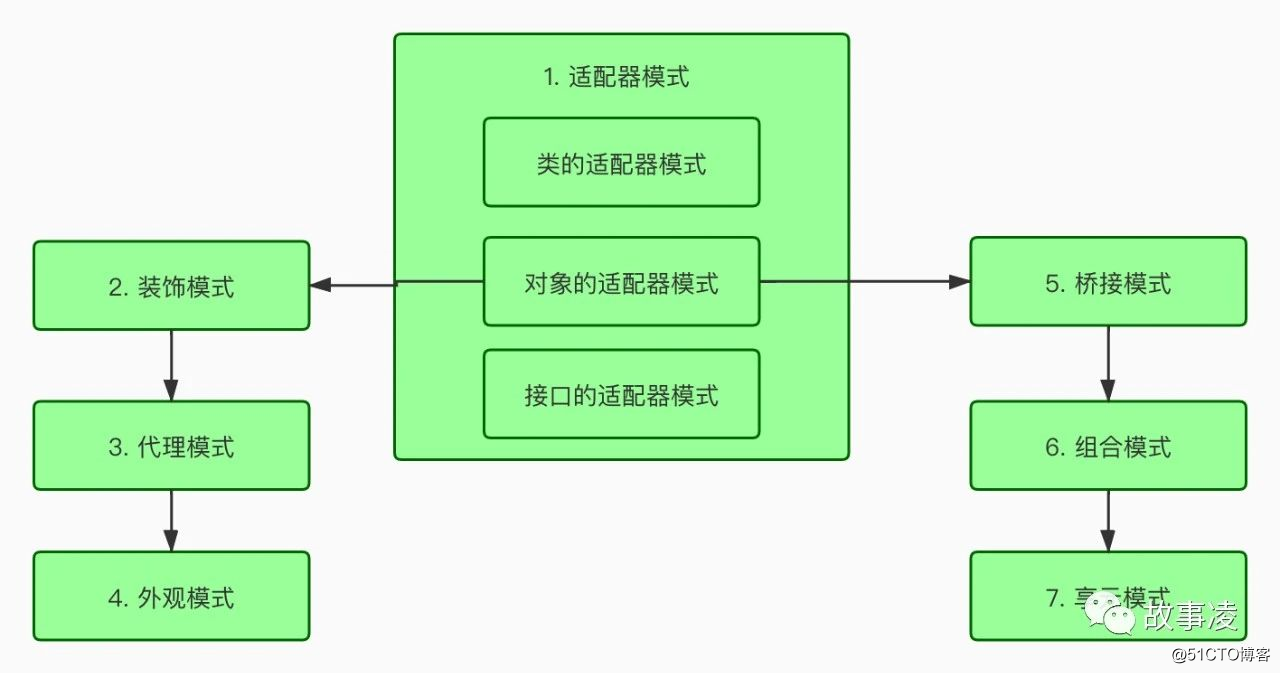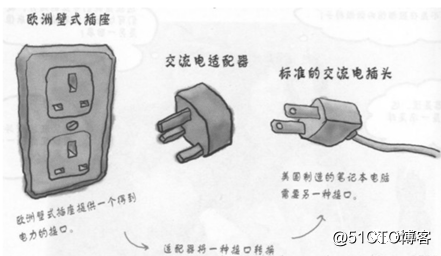标签:abstract sys 自己 bst get mamicode 期望 直接 文章
4. 结构型设计模式我们接着讨论设计模式,上篇文章我讲完了5种创建型模式,这章开始,我将讲下7种结构型模式: 适配器模式, 装饰模式, 代理模式, 外观模式, 桥接模式, 组合模式, 享元模式. 其中对象的适配器模式是各种模式的起源, 我们看下面的图:
适配器模式将某个类的接口转换成客户端期望的另外一个接口表示, 目的是消除由于接口不匹配所造成的的类的兼容性问题. 主要分为三类: 类的适配器模式, 对象的适配器模式, 接口的适配器模式
核心思想就是: 有一个Source类, 拥有一个方法, 待适配, 目标接口是Targetable, 通过Adapter类, 将Source的功能扩展到Targetable里, 看代码:
public class Source {
public void method1() {
System.out.println("this is original method!");
}
}public interface Targetable {
// 与原类中的方法相同
public void method1();
// 新类的方法
public void method2();
}
public class Adapter extends Source implements Targetable {
@Override
public void method2() {
System.out.println("this is the targetable method!")
}
}Adapter类继承Source类, 实现接口Targetable接口, 下面是测试类:
public class AdapterTest {
public static void main(String[] args) {
public static void main(String[] args) {
Targetable target = new Adapter();
target.method1();
target.method2();
}
}
}输出:
this is original method!
this is the targetable method!这样Targetable接口的实现类就具有了Source类的功能.
基本思路和类的适配器模式相同, 只是将Adapter类作修改, 这次不继承Source类, 而是持有Source类的实例, 已达到解决兼容性的问题.
只需要修改Adapter类的源码即可:
public class Wrapper implements Targetable {
private Source source;
public Wrapper(Source source) {
super();
this.source = source;
}
@Override
public void method2() {
System.out.println("this is the targetable method!");
}
@Override
public void method1() {
source.method1();
}
}测试类:
public class AdapterTest {
public static void main(String[] args) {
Source source = new Source();
Targetable target = new Wrapper(source);
target.method1();
target.method2();
}
}输出与第一种一样, 只是适配的方法不同而已
第三种适配器模式是接口的适配器模式, 接口的适配器是这样的: 有时我们写的一个接口中有多个抽象方法, 当我们写该接口的实现类时, 必须实现该接口的所有方法, 这明显有时比较浪费, 因为并不是所有的方法都是我们需要的, 有时只需要某一, 些, 此处为了解决这个问题, 我们引入了接口的适配器模式, 借助于一个抽象类, 该抽象类实现了该接口, 实现了所有的方法, 而我们不和原始的接口打交道, 只和该抽象类取得联系, 所以我们写一个类, 继承该抽象类, 重写我们需要的方法就行.
看代码:
public interface Sourceable {
public void method1();
public void method2();
}抽象类Wrapper2
public abstract class Wrapper2 implements Sourceable {
public void method1(){}
public void method2(){}
}public class SourceSub1 extends Wrapper2 {
public void method1(){
System.out.println("the sourceable interface‘s first Sub1!");
}
}public class SourceSub2 extends Wrapper2 {
public void method2() {
System.out.println("the sourceable interface‘s second Sub2!")
}
}测试类:
public class WrapperTest {
public static void main(String[] args) {
Sourceable source1 = new SourceSub1();
Sourceable source2 = new SourceSub2();
source1.method1();
source1.method2();
source2.method1();
source2.method2();
}
}测试输出:
the sourceable interface‘s first Sub1!
the sourceable interface‘s second Sub2!讲了这么多, 总结一下三种适配器模式的应用场景:
类适配器: 当希望一个类转换成满足另一个新接口的类时, 可以使用类的适配器模式, 创建一个新类, 继承原有的类, 实现新的接口即可.
对象的适配器模式: 当希望将一个对象转换成满足另一个新的接口的对象时, 可以创建一个Wrapper类, 持有原有类的一个实例, 在Wrapper类的方法中, 调用实例的方法就行.
刚开始自己不懂什么叫做适配器的时候, 查资料, 请教同事, 都是拿我们的插座举例,让我刚接触的一个菜鸟就是理解不了本质是什么

适配器就是我们中间的那个插头, 他给我们起一个转换的作用, 所以我们来分析一下适配器的本质:
插座的不管它是什么样的, 它是客观存在的, 而且你重构它的可能性真的不太大, 因为自己写一个插座的成本太高, 首先就是有一个已经成熟可用的, 庞大的, 成体系的东西
主要是我们还想用他们这个东西, 但是我没法直接调用这个东西
说白了就是一种中间转换的思想.就是适配器的模式, 也是符合最小话成本的原则, 要不然自己写就好了.那不管你类也是, 对象也好, 接口也好, 只是实现方式不同而已.
故事凌
明天能否加个鸡腿!
喜欢作者
标签:abstract sys 自己 bst get mamicode 期望 直接 文章
原文地址:https://blog.51cto.com/14901322/2521137